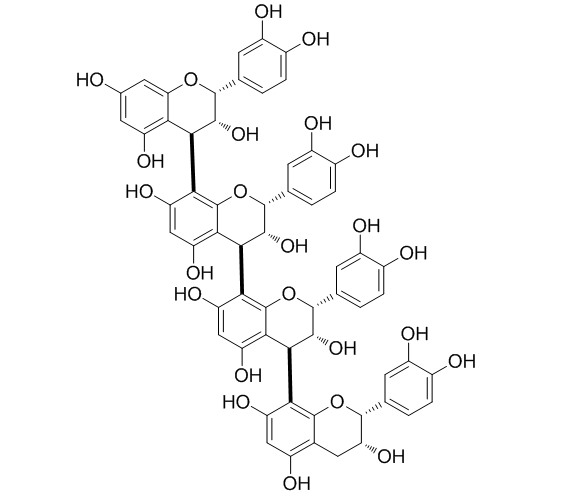Cinnamtannin A2
Cinnamtannin A2 may increase the production of mature form SREBPs and LDL receptor activity, thereby increasing ApoA1 and decreasing ApoB levels.
Inquire / Order:
manager@chemfaces.com
Technical Inquiries:
service@chemfaces.com
Tel:
+86-27-84237783
Fax:
+86-27-84254680
Address:
1 Building, No. 83, CheCheng Rd., Wuhan Economic and Technological Development Zone, Wuhan, Hubei 430056, PRC
Providing storage is as stated on the product vial and the vial is kept tightly sealed, the product can be stored for up to
24 months(2-8C).
Wherever possible, you should prepare and use solutions on the same day. However, if you need to make up stock solutions in advance, we recommend that you store the solution as aliquots in tightly sealed vials at -20C. Generally, these will be useable for up to two weeks. Before use, and prior to opening the vial we recommend that you allow your product to equilibrate to room temperature for at least 1 hour.
Need more advice on solubility, usage and handling? Please email to: service@chemfaces.com
The packaging of the product may have turned upside down during transportation, resulting in the natural compounds adhering to the neck or cap of the vial. take the vial out of its packaging and gently shake to let the compounds fall to the bottom of the vial. for liquid products, centrifuge at 200-500 RPM to gather the liquid at the bottom of the vial. try to avoid loss or contamination during handling.
Molecules.2023, 28(3):958.
ACS Chem Biol.2019, 14(5):873-881
Molecules.2023, 28(18):6734.
Molecules.2022, 27(2):451.
Preprints2021, doi:10.20944
Mol Nutr Food Res.2024, 68(20):e2400414.
Heliyon2020, 6(6):e04337.
J Ginseng Res.2022, 46(1):104-114.
J of Pharmaceutical Analysis2020, doi: 10.1016
Saudi Pharmaceutical Journal2023, 31(12):101829
Related and Featured Products
Journal of Agricultural & Food Chemistry, 2011, 59(4):1470-1476.
Cacao polyphenols influence the regulation of apolipoprotein in HepG2 and Caco2 cells.[Reference:
WebLink]
Cocoa powder is rich in polyphenols, such as catechins and procyanidins, and has been shown to inhibit low-density lipoprotein (LDL) oxidation and atherogenesis in a variety of models. Human studies have also shown daily intake of cocoa increases plasma high-density lipoprotein (HDL) and decreases LDL levels. However, the mechanisms responsible for these effects of cocoa on cholesterol metabolism have yet to be fully elucidated.
METHODS AND RESULTS:
The present study investigated the effects of cacao polyphenols on the production of apolipoproteins A1 and B in human hepatoma HepG2 and intestinal Caco2 cell lines. The cultured HepG2 cells or Caco2 cells were incubated for 24 h in the presence of cacao polyphenols such as (-)-epicatechin, (+)-catechin, procyanidin B2, procyanidin C1, and Cinnamtannin A2. The concentration of apolipoproteins in the cell culture media was quantified using an enzyme-linked immunoassay, and the mRNA expression was quantified by RT-PCR. Cacao polyphenols increased apolipoprotein A1 protein levels and mRNA expression, even though apolipoprotein B protein and the mRNA expression were slightly decreased in both HepG2 cells and Caco2 cells. In addition, cacao polyphenols increased sterol regulatory element binding proteins (SREBPs) and activated LDL receptors in HepG2 cells.
CONCLUSIONS:
These results suggest that cacao polyphenols may increase the production of mature form SREBPs and LDL receptor activity, thereby increasing ApoA1 and decreasing ApoB levels. These results elucidate a novel mechanism by which HDL cholesterol levels become elevated with daily cocoa intake.
Agricultural & Biological Chemistry, 1986, 50(8):2061-2067.
Isolation and structures of procyanidins (condensed tannins) from Rhaphiolepis umbellata.[Reference:
WebLink]
METHODS AND RESULTS:
Two new procyanidin trimers (1, 3) and one tetramer (2) were isolated in their free phenolic forms from the bark of Rhaphiolepis umbellata, which is used as the dyeing agent for Oshima Tsumugi. On the basis of 1H- and 13C-NMR spectral examinations and the results of partially acidcatalyzed degradation, 1, 2 and 3 were characterized as epicatechin-(4β→8)-epicatechin-(4β→6)-epicatechin, epicatechin-(4β→8)-epicatechin-(4β→8)-epicatechin-(4β→6)-epicatechin andcatechin(4α→6)-epicatechin-(4β→8)-epicatechin, respectively. In addition, the occurrence of the known compounds, i.e., (-)-epicatechin (4), procyanidins B-l (9), B-2 (5), B-5 (6) and C-l (7), proanthocyanidin A-2 (10), cinnamtannin A1 (8) and Cinnamtannin A2 (14), cinchonains la (11) and lib (12), and (-)-catechin 7-O-β-D-glucopyranoside (13) in the bark of Rhaphiolepis umbellata was confirmed.



